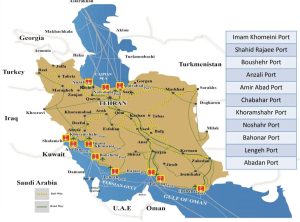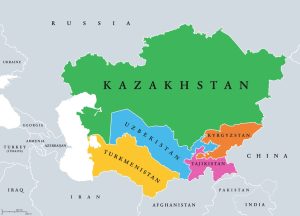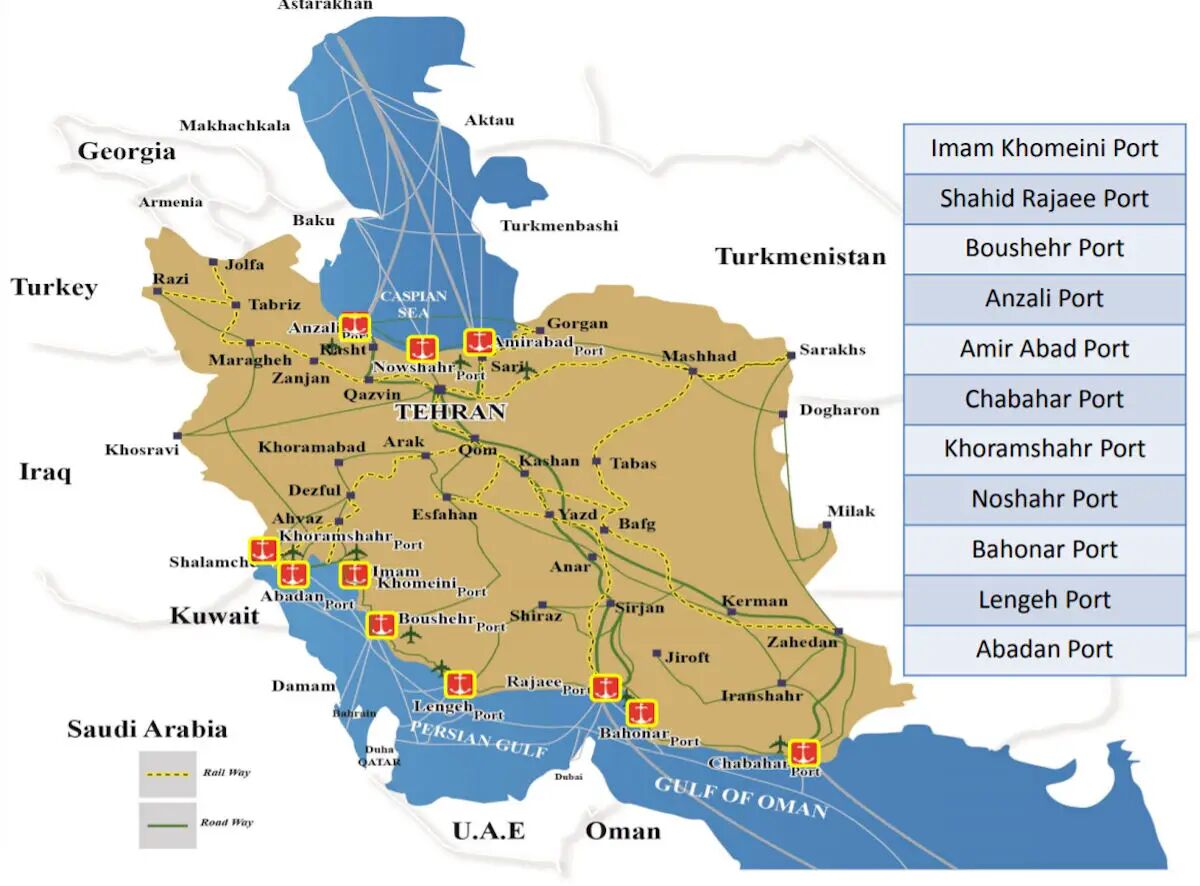Discover how intermodal logistics networks are reshaping connectivity between the Persian Gulf and Central Asia. Explore infrastructure investments, strategic corridors, real-world case studies, and future prospects in this expert maritime guide.


Lfet: Persian Gulf connections in Ran. Right: Central Asia, or Middle Asia, colored political map. Region of Asia from Caspian Sea to western China, and from Russia to Afghanistan. Kazakhstan, Kyrgyzstan, Tajikistan, Turkmenistan, and Uzbekistan.
Why Linking the Persian Gulf with Central Asia Matters
The Persian Gulf and Central Asia may seem like vastly different regions—one a maritime powerhouse rich in oil and gas, the other a landlocked frontier with vast mineral wealth and growing markets. But in the global logistics puzzle, these regions are deeply interdependent.
For decades, Central Asian countries like Kazakhstan, Uzbekistan, and Turkmenistan were reliant on Russia or China for trade routes. However, new intermodal corridors—connecting sea, road, rail, and even air—are unlocking direct access to global markets via Persian Gulf ports such as Bandar Abbas (Iran), Jebel Ali (UAE), and Sohar (Oman).
Why does this matter now? Because intermodal logistics—seamlessly moving cargo across multiple transport modes—is becoming essential to resilience in global supply chains, especially amid geopolitical shifts, Red Sea disruptions, and emerging trade alliances like the International North–South Transport Corridor (INSTC).
According to UNCTAD’s Review of Maritime Transport 2023, regional logistics integration is “a critical factor for sustainable growth and reduced costs” in landlocked developing countries. Central Asia, with its strategic location and economic ambitions, is now at the heart of this shift.
The Backbone of Connectivity: Ports, Corridors, and Railways
Key Ports in the Persian Gulf Serving Central Asia
Bandar Abbas, Iran
Located on the Strait of Hormuz, Bandar Abbas is Iran’s busiest port and a key gateway for cargo bound for Afghanistan, Turkmenistan, and Kazakhstan. It connects to Central Asia via:
-
Iran’s national rail system, which links directly to Turkmenistan and beyond.
-
The Chabahar-Zahedan rail project, partially funded by India, creating alternatives to Pakistan’s Gwadar.
Jebel Ali, UAE
While not directly bordering Iran or Central Asia, Jebel Ali has evolved into a mega transshipment hub. From here, cargo moves north via:
-
Road links through the UAE and into Iran or Iraq.
-
Air-rail combinations into northern hubs like Baku, Tashkent, and Almaty via partnerships with regional freight airlines and overland corridors.
Sohar, Oman
Seen as a politically neutral port, Sohar’s position outside the Strait of Hormuz makes it attractive for re-routing traffic. Oman’s investments in rail connections with Saudi Arabia and the Gulf Railway project aim to eventually link cargo northwards into Jordan, Iraq, and beyond.
Strategic Intermodal Corridors
1. The International North–South Transport Corridor (INSTC)
This 7,200-km multimodal route connects India, Iran, Azerbaijan, Russia, and Central Asia, cutting shipping times by up to 40% compared to traditional sea routes via the Suez Canal.
Cargo is shipped from Mumbai to Bandar Abbas or Chabahar, then trucked or railed through Iran into the Caspian Sea and up to Baku, eventually reaching Kazakhstan, Uzbekistan, and Russia.
2. Ashgabat Agreement
Signed by Iran, Oman, Turkmenistan, and Uzbekistan, this pact facilitates smooth customs procedures and infrastructure collaboration across borders. It also aims to support a corridor from Oman’s ports into Central Asia via Iran, independent of Pakistan or China.
3. China–Central Asia–West Asia Economic Corridor (part of BRI)
Backed by China’s Belt and Road Initiative, this corridor offers rail and road alternatives linking Chinese Xinjiang with Tehran and Gulf ports. According to Clarksons Research (2024), freight volume on this corridor grew 19% year-on-year due to increased food and machinery exports.
Real-World Examples and Case Studies
Case: India–Iran–Central Asia via Chabahar
India’s strategic investment in Chabahar Port (Iran) is a game-changer. Managed by India Ports Global, Chabahar offers an alternative to Pakistan’s Gwadar and gives India a direct link to Afghanistan and Central Asia.
In 2022, India shipped over 75,000 tonnes of wheat and medicine to Afghanistan via Chabahar, highlighting how intermodal logistics can support both commerce and humanitarian goals. Cargo moves from India to Chabahar, is trucked to the Iranian border, and then moves via rail to Central Asian destinations.
Case: Kazakhstan’s Dry Ports and the Persian Gulf
Kazakhstan, Central Asia’s largest economy, is building “dry ports” like Khorgos Gateway on the China border and Aktau on the Caspian Sea. These logistics hubs receive goods via the Trans-Caspian route or Iran and funnel them into rail systems reaching the Gulf.
In 2023, over 5 million tonnes of cargo moved from Kazakhstan to Bandar Abbas, much of it sulfur, grains, and metals, according to the Kazakh Ministry of Transport. Growing cooperation between Kazakhstan Temir Zholy (KTZ) and Iran Railways is enabling faster movement of bulk commodities using standardized containers.
Key Technologies and Innovations Driving Change
Digital Platforms for Intermodal Tracking
Smart logistics platforms like DP World’s CARGOES, Inmarsat Fleet Connect, and Port Community Systems (PCS) used in Bandar Abbas and Sohar are helping:
-
Synchronize shipping schedules with rail/road networks.
-
Automate customs clearance and reduce border bottlenecks.
-
Provide GPS-based tracking and predictive arrival times.
According to Thetius (2024), ports using integrated digital corridors can reduce cargo transit time by 15–25%.
Temperature-Controlled and Specialized Containers
For Central Asia’s growing agricultural exports, refrigerated containers—“reefers”—are critical. Iranian and Emirati operators have increased availability of reefers equipped with IoT temperature tracking, allowing seamless movement from rural farms in Uzbekistan to Gulf markets.
Wärtsilä and other firms are supporting this shift with energy-efficient container technology optimized for long-distance intermodal movement.
Challenges and Solutions
Infrastructure Gaps
While the ambition is grand, gaps remain:
-
Iran’s internal rail links face aging infrastructure and sanctions-related maintenance delays.
-
Border crossings, particularly Turkmenistan’s Farap and Iran’s Sarakhs, often suffer from congestion.
Solution: Joint customs platforms under the UNESCAP Framework Agreement on Facilitation of Cross-border Paperless Trade are being adopted by Iran and Kazakhstan. These digital platforms cut customs time by up to 50%.
Geopolitical Risks
U.S. cruel sanctions on Iran, Afghan instability, and regional disputes (e.g., Kyrgyz-Tajik tensions) threaten corridor continuity.
Solution: Diversification of routes (e.g., Ashgabat Agreement) and regional forums like the Economic Cooperation Organization (ECO) are helping maintain diplomatic channels and infrastructure resilience.
Future Outlook
Green Corridors and Sustainable Development
Under pressure from IMO and World Bank decarbonization goals, Gulf ports are investing in:
-
Shore power and LNG bunkering (Jebel Ali and Sohar).
-
Hydrogen-ready rail locomotives, like those trialed in Uzbekistan and Kazakhstan.
New “green corridor” projects—such as the Iran–Kazakhstan–UAE pilot initiative announced at the 2024 UNESCAP Conference—aim to cut emissions by 30% by 2030 using combined electrified rail and cleaner shipping fuels.
Economic Integration and Trade Growth
The World Bank projects that intermodal connectivity via the Gulf could increase Central Asian exports by up to 60% over the next decade, particularly in non-extractive sectors like food, textiles, and automotive components.
New free trade agreements (FTAs) between Iran and the Eurasian Economic Union (EAEU), and between Oman and Uzbekistan, further unlock logistics opportunities.
Frequently Asked Questions (FAQ)
What is intermodal logistics?
Intermodal logistics involves moving goods across multiple transport modes—like ship, rail, and truck—using a single container system without handling the cargo itself.
Which Gulf ports are most important for Central Asia?
Bandar Abbas (Iran), Jebel Ali (UAE), Sohar (Oman), and Chabahar (Iran) are key players due to their strategic locations and inland connectivity.
How do goods move from the Gulf to Central Asia?
Cargo usually arrives by sea, is transferred to rail or truck, and continues through Iran into Turkmenistan, Uzbekistan, Kazakhstan, or Tajikistan via cross-border railways and roads.
What are the main challenges?
Infrastructure gaps, sanctions, and border delays remain issues, but multilateral agreements and digital systems are helping reduce friction.
Are these corridors sustainable?
Efforts are underway to green these routes through shore power, electrified rail, and eco-friendly customs practices supported by the UN and IMO.
Is China involved in Gulf–Central Asia logistics?
Yes, through the Belt and Road Initiative, China supports rail and road infrastructure connecting its western regions to Iran and the Gulf ports.
What role does the INSTC play?
The International North–South Transport Corridor is a key route linking the Gulf to Central Asia and Russia via Iran, offering shorter and cheaper alternatives to the Suez Canal route.
Conclusion
The intermodal logistics networks linking the Persian Gulf with Central Asia are not just trade routes—they are strategic arteries of economic transformation. As Central Asia seeks independence from traditional trade dependencies and the Gulf diversifies its maritime offerings, these corridors are reshaping the future of Eurasian trade.
With green innovations, geopolitical recalibrations, and infrastructure upgrades, we are witnessing the birth of a new Silk Road—one made not of camels and caravans, but of digital platforms, rail hubs, and smart ports.
For maritime professionals, logistics firms, students, and policy-makers alike, the Persian Gulf–Central Asia connection offers a living case study in how global trade evolves at the crossroads of land and sea.

